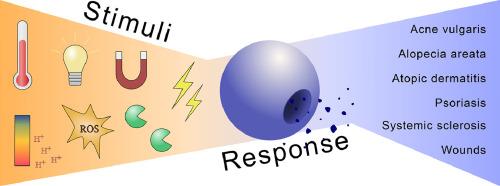Stimuli-responsive drug delivery systems for inflammatory skin conditions
IF 9.4
1区 医学
Q1 ENGINEERING, BIOMEDICAL
引用次数: 0
Abstract
Inflammatory skin conditions highly influence the quality of life of the patients suffering from these disorders. Symptoms include red, itchy and painful skin lesions, which are visible to the rest of the world, causing stigmatization and a significantly lower mental health of the patients. Treatment options are often unsatisfactory, as they suffer from either low patient adherence or the risk of severe side effects. Considering this, there is a need for new treatments, and notably of new ways of delivering the drugs. Stimuli-responsive drug delivery systems are able to deliver their drug cargo in response to a given stimulus and are, thus, promising for the treatment of inflammatory skin conditions. For example, the use of external stimuli such as ultraviolet light, near infrared radiation, or alteration of magnetic field enables drug release to be precisely controlled in space and time. On the other hand, internal stimuli induced by the pathological condition, including pH alteration in the skin or upregulation of reactive oxygen species or enzymes, can be utilized to create drug delivery systems that specifically target the diseased skin to achieve a better efficacy and safety. In the latter context, however, it is of key importance to match the trigger mechanism of the drug delivery system to the actual pathological features of the specific skin condition. Hence, the focus of this article is placed not only on reviewing stimuli-responsive drug delivery systems developed to treat specific inflammatory skin conditions, but also on critically evaluating their efficacy in the context of specific skin diseases.
Statement of significance
Skin diseases affect one-third of the world's population, significantly lowering the quality of life of the patients, who deal with symptoms such as painful and itchy skin lesions, as well as stigmatization due to the visibility of their symptoms. Current treatments for inflammatory skin conditions are often hampered by low patient adherence or serious drug side effects. Therefore, more emphasis should be placed on developing innovative formulations that provide better efficacy and safety for patients. Stimuli-responsive drug delivery systems hold considerable promise in this regard, as they can deliver their cargo precisely where and when it is needed, reducing adverse effects and potentially offering better treatment outcomes.

针对炎症性皮肤病的刺激响应式给药系统。
炎症性皮肤病严重影响患者的生活质量。其症状包括皮损发红、发痒和疼痛,这些症状在世界上其他地方都能看到,导致患者蒙受耻辱,精神健康状况明显下降。治疗方案往往不能令人满意,因为它们要么患者依从性低,要么存在严重副作用的风险。有鉴于此,我们需要新的治疗方法,尤其是新的给药方式。刺激响应式给药系统能够在特定刺激下给药,因此在治疗皮肤炎症方面前景广阔。例如,利用紫外线、近红外辐射或磁场变化等外部刺激,可以在空间和时间上精确控制药物释放。另一方面,可利用病理条件引起的内部刺激,包括皮肤 pH 值的改变或活性氧或酶的上调,创建专门针对病变皮肤的给药系统,以达到更好的疗效和安全性。不过,在后一种情况下,关键是要使给药系统的触发机制与特定皮肤病的实际病理特征相匹配。因此,本文的重点不仅在于回顾为治疗特定炎症性皮肤病而开发的刺激响应式给药系统,还在于对其在特定皮肤病中的疗效进行批判性评估。意义说明:皮肤病影响着全球三分之一的人口,大大降低了患者的生活质量,他们不仅要面对皮损疼痛和瘙痒等症状,还要因症状明显而蒙受耻辱。目前对炎症性皮肤病的治疗往往因患者依从性低或严重的药物副作用而受阻。因此,应更加重视开发创新配方,为患者提供更好的疗效和安全性。在这方面,刺激响应式给药系统大有可为,因为它们可以在需要的时间和地点精确地给药,减少不良反应,并可能提供更好的治疗效果。
本文章由计算机程序翻译,如有差异,请以英文原文为准。
求助全文
约1分钟内获得全文
求助全文
来源期刊

Acta Biomaterialia
工程技术-材料科学:生物材料
CiteScore
16.80
自引率
3.10%
发文量
776
审稿时长
30 days
期刊介绍:
Acta Biomaterialia is a monthly peer-reviewed scientific journal published by Elsevier. The journal was established in January 2005. The editor-in-chief is W.R. Wagner (University of Pittsburgh). The journal covers research in biomaterials science, including the interrelationship of biomaterial structure and function from macroscale to nanoscale. Topical coverage includes biomedical and biocompatible materials.
 求助内容:
求助内容: 应助结果提醒方式:
应助结果提醒方式:


